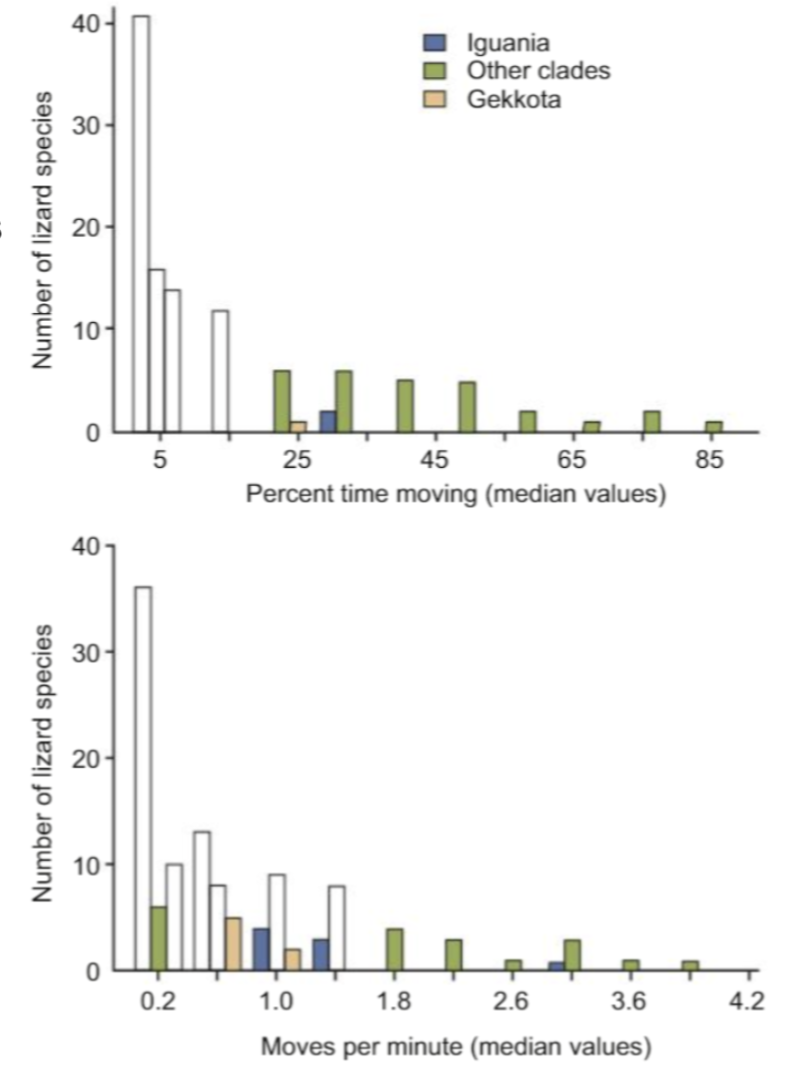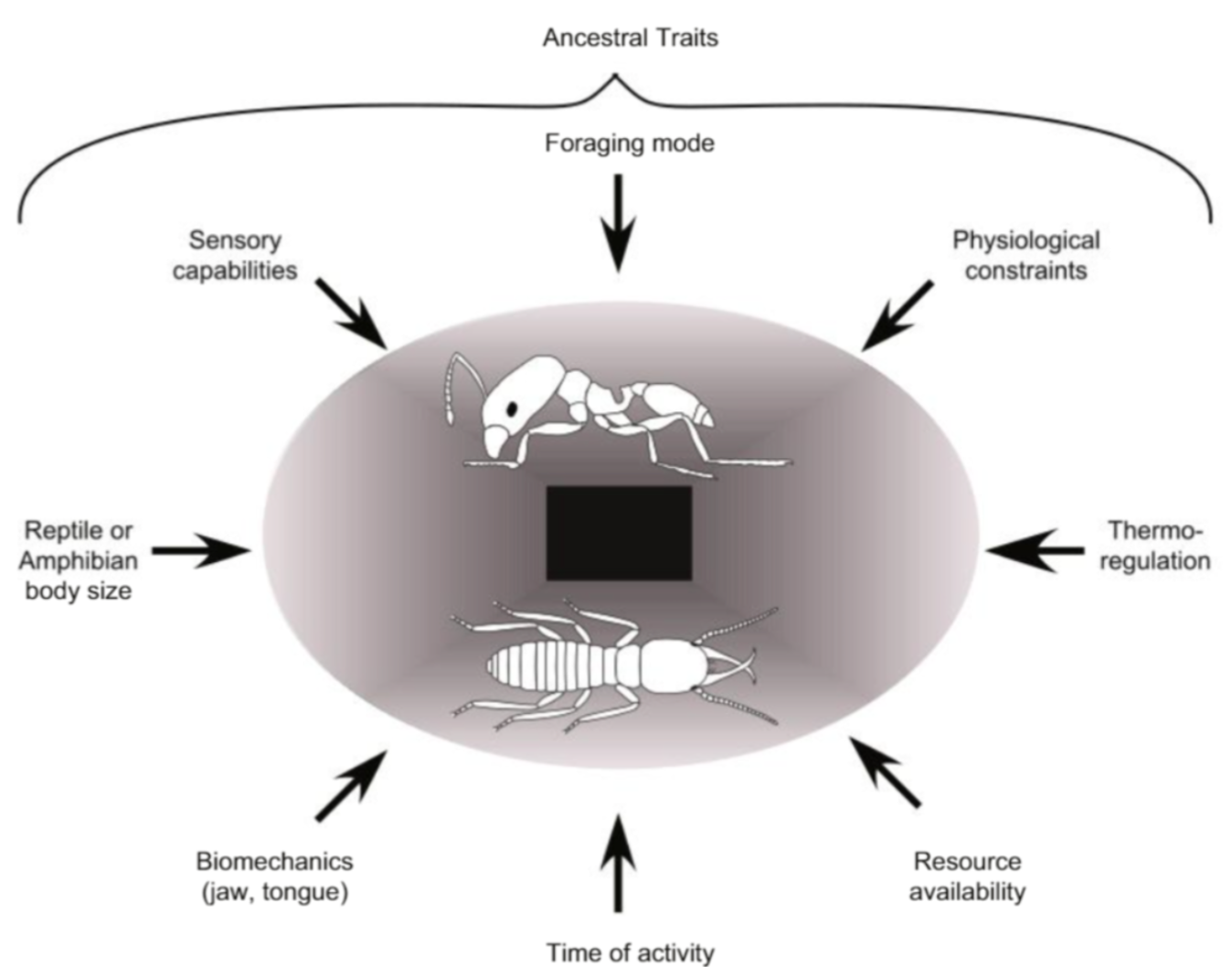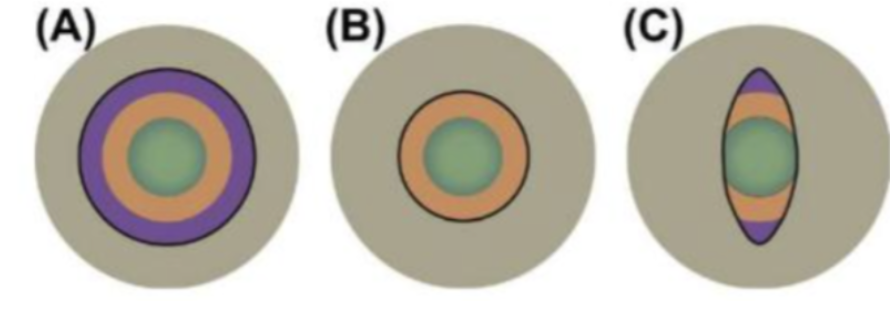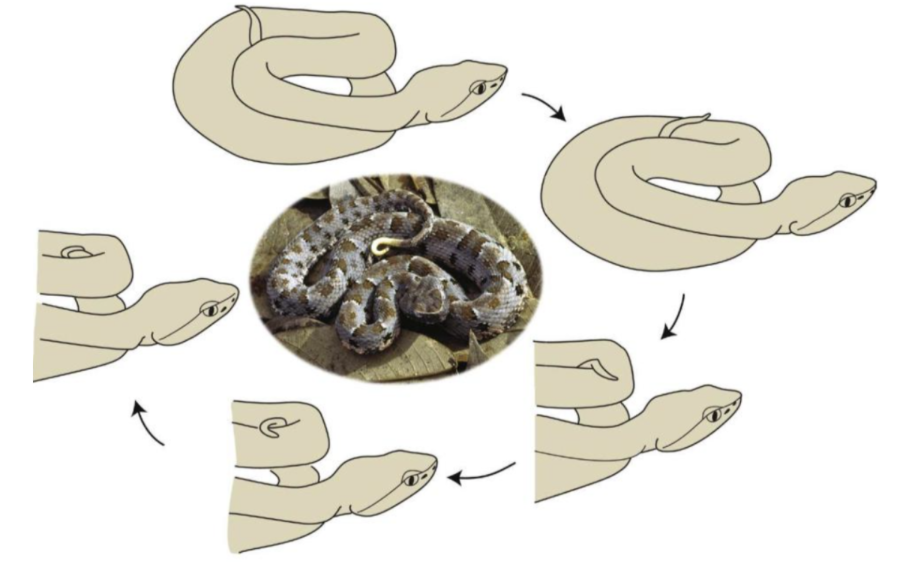Herpetology: Chapter 10
1/29
There's no tags or description
Looks like no tags are added yet.
Name | Mastery | Learn | Test | Matching | Spaced |
|---|
No study sessions yet.
30 Terms
What are the two foraging modes?
Sit and wait and active foraging
What is the theory of foraging based on?
Foraging behavior is evolutionarily plastic and responds to differences in prey abundance and behavior.
How does bimodality of sit and wait versus active foraging appear?
appears obvious within single assemblages of species. In other words, you are not going to see sit and wait foraging and active foraging in the same species today.
Bimodality is evident when confounding effects of phylogeny are removed

Explain this figure
blue and orange tend to be clumped together, they are not alll across the spectrum. Meaning they are constrained. Exemplifies that it is not a continuum
Why are extremes in foraging behavior evident?
They do not evolve in a vacuum
What is optimal foraging theory?
It is a popular explanation for evolution of foraging modes, animals best able to harvest resources should be at a selective advantage when competition among individuals exists.
What factors influence optimal foraging theory?
external, internal and historical factors influence ability of individual organisms to acquire food. Abiotic and biotic factors
Body size: bigger animal is more likely to survive
Biomechanics: strength of jaw and tongue
Physiological constraints: run speed
Time of activity: activity different from competitors
Resource avaliability
sensory capabilities
foraging mode
thermoregulation

Visual prey detection
Prey of herps can be detected by visual, chemical, tactile or thermal cues. Visual detection is used by most herps that are sit and wait predators. Requires ability to distinguish movement.
Frogs are able to respond to prey that appear anywhere in their 360 field of vision. More likely to go for the thing directly in front of them. Frogs detect movement and are opportunistic
Extensive use of vision in prey capture also apparent from the number of diurnal and nocturnal species with well developed eyes.

Pupil shape (explain each)
A: low light, fully dilated, all types of light, focus on different colors
B: iris constricts cones and rods of this color no longer see light
C: vertical slit, lets less light while maintaining visual constitutely
Pupils in the shape of slits allow use of full diameter of lens in low or bright light.
Chemosensory types
Olfaction (smell)
Taste: allows to discriminate prey (NOT locate) but to give info about whether or not it is worth eating
Vomerofaction: use of Jacobson’s organ
What are the common feeding senses used in salamanders and many squamates?
Olfaction and vomerofaction
What animal group do we see the historical basis with much of the variation in using chemical cues?
Squamates
Vomerofaction
Use of Jacobson’s organ paired with forked tongue. The tongue collects chemicals and deposits into organ to detect concentration of chemicals to figure out where is prey.
(similar to a sense of smell in us, but we can only detect magnitude, not location)
Chemosensory evolution
There is ancestral condition that split to no use to use of chemosensory with only some instances where species switch, but overall ability to use chemosensory is conserved (unlikely to change)
Thermal prey detection
Some snakes use thermal cues to locate and orient on prey. Seen in boas, pythons, many viperids. They have infrared sensitive pits either along jawline or at the front of the jaw.
They detect changes in temperature which can determine thermal profile of what is in front of them.
Looks at how much heat is being refracted, more heat means the prey is larger. Detection of relative changes in heat signal. Can also help detect movement if alive or not.
Works with vision to create holistic picture.
Tactile prey detection
Poorly understood in herps. Usually sit and wait foragers.
Seen in alligator snapping turtle. Tongue looks like worm and as fish moves in turtle knows to close its mouth.
Common modes of prey capture and digestion
most herps swallow prey whole
some herps use lures to attract their prey
Describe the two different tongue mechanisms
Tongue is folded back in mouth and muscle pulls down on mentomechelian element to catapult the tongue to catch prey, seen in frogs
Projectile tongue, seen in salamanders and chameleons that extends outwards by applying tension to structure that holds tongue in place. Has a sticky glandular surface. Bone that fires out, subarcualis rectus
Prey capture using lure (include example)
behavior and tactile technique where a lure is used to draw prey in.
Seen in Iranian spider-viper has lure on tail looks like insect that lures in bird.

Fragmentation of food (biting and grasping of food)
seen in herbivores. Size is not a problem since they can just take a bite. Some large lizards, turtles and crocs can use sharp teeth and claws to break up items. Turtles have continuously growing keratinous sheaths on jaws, each provides blade like surface for cutting food.
What happens after prey has been captured?
Must move through oral cavity into esophagus
Constriction
specialized bite and grasp technique used by many snakes. It is best known in boas and pythons.
They can modify pressure and duration of constriction based on heartbeat of prey. Some highly venomous snakes constrict prey after biting and injecting venom. Being able modify it helps to use the right amount of energy, conserve it while subduing prey. Aim to cause cardiovascular arrest.
Injected venom
Venom delivery systems have evolved independently at least twice within Squamata.
Fangs in snakes likely arose only once and are homologous.
Venom of each snake species is a composite of several compounds that work together to subdue prey.
What are the four elements of injected venom?
Glands to produce venom
Ducts for transport
Muscles to force venom from gland- masseter muscle
fangs to inject
Filter feeding
not seen in any adult herps, only seen in tadpoles. Buccal cavity has patches and gills filter out small particles with large particles getting trapped in patches for the animal to then consume.
System that includes branchial food traps and gill filters in the pharynx, papillae funnel large particles into esophagus.
Some tadpoles have buccal beak to scrape algae (with same filter system)
The buccopharyngeal cavity of tadpoles is large, more than half the volume of the head.
What factors determine the kinds of prey a species will eat?
most herps eat a variety of prey types and sizes. A multitude of factors determined kinds of prey a species will eat
Dependent upon habitat, food availability, body size,
What animals forage under water?
Sea turtles on algae, grasses, jellyfish, sponges
Sea snakes on fishes and inverts
Iguanas on algae scraped off rock surfaces
What data is used in dietary studies?
data on stomach-content
Herbivory in herps
In amphibians, herbivory is almost entirely limited to anuran tadpoles
Obligate herbivory absent in adult amphibians and uncommon in adult reptiles
Herbivory poses digestive problems with breaking down cellulose, evolution of gut microflora acquisition unknown
If herps are herbivores it is because body size does not matter. Galapagos turtles move slowly so it benefits them to eat plants because volumetrically eat a ton of food a lot of it ends up being waste. Advantageous.
How to diets evolve in herps?
They evolve just as morphological or physiological traits do.